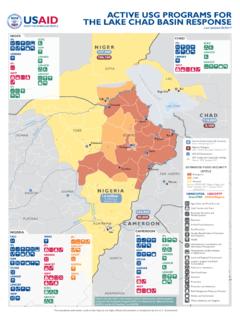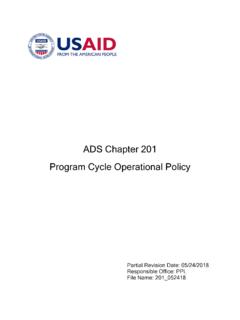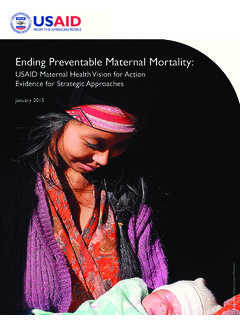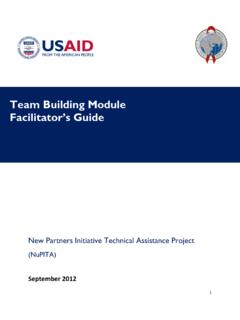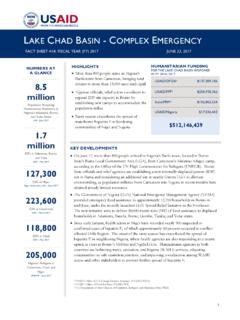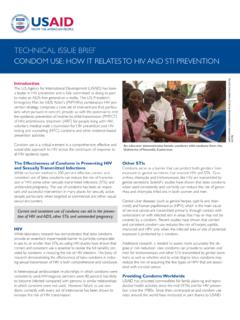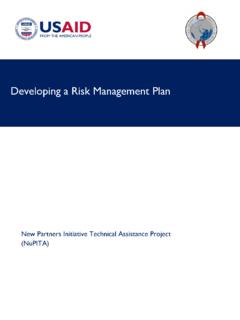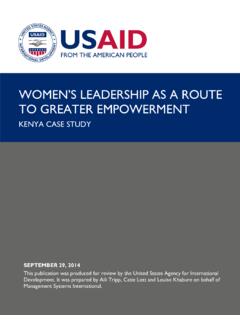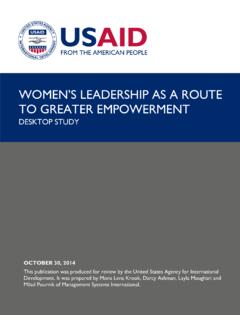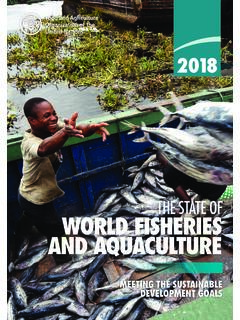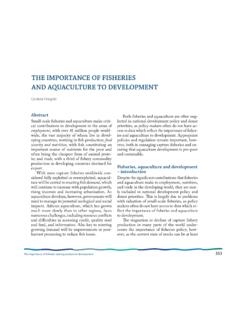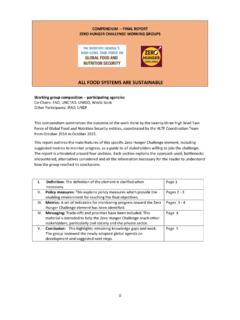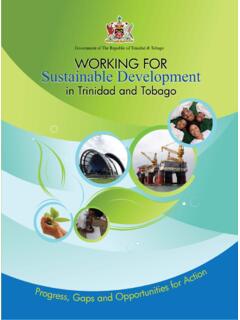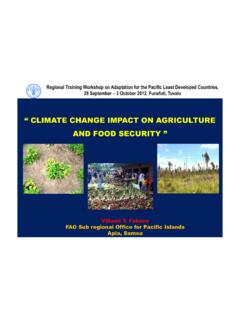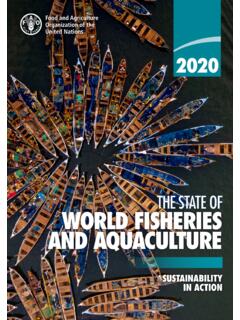Transcription of SUSTAINABLE FISHERIES AND RESPONSIBLE AQUACULTURE
1 SUSTAINABLE FISHERIES AND RESPONSIBLE AQUACULTURE : A Guide for USAID Staff and Partners June 2013 ABOUT THIS GUIDEGOALThis guide provides basic information on how to design programs to reform capture FISHERIES (also referred to as wild FISHERIES ) and AQUACULTURE sectors to ensure sound and effective development, environmental sustainability, economic profitability, and social responsibility. To achieve these objectives, this document focuses on ways to reduce the threats to biodiversity and ecosystem productivity through improved governance and more integrated planning and management practices. In the face of food insecurity, global climate change, and increasing population pressures, it is imperative that development programs help to maintain ecosystem resilience and the multiple goods and services that ecosystems provide.
2 Conserving biodiversity and ecosystem functions are central to maintaining ecosystem integrity, health, and intent of the guide is not to suggest that FISHERIES and AQUACULTURE are interchangeable: these sectors are unique although linked. The world cannot afford to neglect global FISHERIES and expect AQUACULTURE to fill that void. Global food security will not be achievable without reversing the decline of FISHERIES , restoring FISHERIES productivity, and moving towards more environmentally friendly and RESPONSIBLE AQUACULTURE . There is a need for reform in both FISHERIES and AQUACULTURE to reduce their environmental and social s experience has shown that well-designed programs can reform capture FISHERIES management, reducing threats to biodiversity while leading to increased productivity, incomes, and livelihoods.
3 Agency programs have focused on an ecosystem-based approach to management in conjunction with improved governance, secure tenure and access to resources, and the application of modern management practices. Such programs contribute to broader development goals, including food security , adaptation to climate change, biodiversity conservation, improved governance and rule of law, poverty reduction, population and family planning, and sound economic growth. USAID s work in these fields has also shown that well-designed programs can reform the AQUACULTURE sector, reducing threats to biodiversity and the environment while contributing to sound economic growth, food security , increased trade, livelihoods, and foreign guide addresses the following questions: Why is it essential for reform to focus on maintaining ecosystem resilience and biodiversity, especially in light of global climate change and other global stressors?
4 Why is it essential for reform to focus on sustainability and responsibility? What should a USAID manager know to design, implement, manage, and evaluate capture FISHERIES and AQUACULTURE programs? How does one design activities to ensure that SUSTAINABLE development goals are addressed using environmentally RESPONSIBLE practices? What are the recognized best practices for SUSTAINABLE FISHERIES and RESPONSIBLE AQUACULTURE ?COVER PHOTO:A small-scale FISHERIES landing site in Bagamoyo District of Tanzania. Photo Credit: Kathy CastroThis publication was produced for review by the United States Agency for International Development. It was prepared by the University of Rhode Island/Coastal Resources Center, in cooperation with USAID technical staff and FISHERIES ANDRESPONSIBLE AQUACULTURE : A Guide for USAID Staff and PartnersJune 2013 DISCLAIMERThe authors views expressed in this publication do not necessarily reflect the views of the United States Agency for International Development or the United States guide is made possible by the generous support of the American people through the United States Agency for International Development (USAID).
5 It was funded through Cooperative Agreement No. EPP-A-00-04-00014-00 to the University of Rhode guide is intended primarily for USAID staff and implementing partners, but should also be useful to a broader audience, including multiple stakeholders within and across guide addresses capture FISHERIES and AQUACULTURE in separate sections, except for the discussion of post-harvest issues where many of the topics are common to both sectors. In practice, capture FISHERIES and AQUACULTURE are usually dealt with as separate sectors. However, greater attention needs to be paid to the real and potential interactions between the two sectors, especially negative impacts of AQUACULTURE on the productivity of capture FISHERIES .
6 Greater attention must also be given to the growing demand for water, the loss of biodiversity, and the encroachment and ecological degradation from coastal and inland development. Much of the capture FISHERIES discussion focuses on coastal and marine FISHERIES . However, many of the approaches and principles presented apply as well to freshwater and inland FISHERIES found in most of the world s lakes, rivers, and seasonal water bodies. The FISHERIES section of the guide focuses on nearshore marine and inland FISHERIES , as this segment of the industry employs more people and comprises a larger percentage of total catch, by weight and value, in most developing countries. The emphasis in the guide is on small-scale FISHERIES .
7 That said, in many cases it is impossible to address problems of the small-scale sector without including analysis and simultaneous reforms in the large-scale industrial sector. The AQUACULTURE section concentrates on reforming the sector for environmental, financial, and social sustainability, with an emphasis on food production for the poor and the utilization of local or native species. The introductory section also emphasizes the important linkages of capture FISHERIES and AQUACULTURE to other sectors such as biodiversity conservation, economic growth, food security , and public health, as well as governance reform that supports participatory democracy and conflict more information or feedback on this Guide, please contact: guide was prepared under the direction of USAID technical staff, including Richard Volk and Barbara Best of the Bureau for Economic Growth, Education and Environment (E3), and Harry Rea of the Bureau for food security (BFS).
8 We would like to acknowledge the individuals who have assisted in preparing and writing the document, especially Maria Haws from the University of Hawaii at Hilo and Kathy Castro, Jim Tobey, Lesley Squillante, Bob Bowen, and Brian Crawford from the University of Rhode Island. Also, many thanks for constructive and thoughtful inputs and review comments of earlier versions from colleagues at the Department of State, National Oceanic and Atmospheric Administration, WorldFish Center, The Nature Conservancy, and World Wildlife Fund, among .. viiiI. INTRODUCTION .. AN OVERVIEW OF FISHERIES AND AQUACULTURE .. 2 CAPTURE OR WILD FISHERIES ..2 AQUACULTURE .. USAID S ROLE IN FISHERIES AND AQUACULTURE .. 4 SOURCES FOR MORE INFORMATION.
9 THE NEED FOR REFORM .. 6 CAPTURE FISHERIES ..7 AQUACULTURE ..8 INTEGRATED APPROACHES TO MANAGEMENT ..9 SOURCES FOR MORE INFORMATION.. CONTRIBUTIONS TO OTHER SECTORS..11 BIODIVERSITY CONSERVATION .. 11 ECONOMIC GROWTH, ENTERPRISE DEVELOPMENT, AND PUBLIC-PRIVATE PARTNERSHIPS..11 GENDER AND MARGINALIZED GROUPS .. 12 POPULATION, HEALTH AND HIV/AIDS .. 13 GLOBAL CLIMATE CHANGE..14 DISASTER MITIGATION AND RESPONSE .. 15 food security AND NUTRITION..17 DEMOCRACY AND GOVERNANCE .. 17 SOURCES FOR MORE INFORMATION.. PRINCIPLES FOR SUSTAINABLE FISHERIES AND RESPONSIBLE AQUACULTURE ..23II. CAPTURE FISHERIES .. AN OVERVIEW OF CAPTURE FISHERIES ..26 INTRODUCTION .. 26 SOME BASIC CONCEPTS..27 KEY THREATS AND MANAGEMENT ISSUES.
10 30 SOURCES FOR MORE INFORMATION.. MANAGEMENT APPROACHES ..35 HOW DO WE MANAGE ACCESS? .. 36CO-MANAGEMENT..37 ECOSYSTEM-BASED FISHERIES MANAGEMENT..38 USE RIGHTS .. 40 OUTPUT CONTROLS..41 INPUT CONTROLS .. 41NO-TAKE OR FISHERY RESERVES .. 42 VOLUNTARY AND INCENTIVE-BASED APPROACHES .. 45 TRADE..48 ACCESS AGREEMENTS .. 49 SUBSIDIES .. 50 RESEARCH AND EXTENSION SERVICES..50 SOURCES FOR MORE INFORMATION.. FISHERIES PROGRAM PLANNING ..53 CONSIDERATION OF SCALE..53 STAKEHOLDER PARTICIPATION .. 55 ISSUE IDENTIFICATION AND ASSESSMENT .. 56 PLANNING AND PROGRAM DESIGN .. 60 IMPLEMENTATION .. 63 EVALUATION AND ADAPTIVE MANAGEMENT .. 66 SOURCES FOR MORE INFORMATION..68 III. AQUACULTURE .. AN OVERVIEW OF AQUACULTURE .
